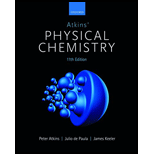
Interpretation:
The rate law for the decomposition of the ozone in the reaction has to be derived.
Concept introduction:
Rate law: It is generally the rate equation that consists of the reaction rate with the concentration or the pressures of the reactants and constant parameters.
Explanation of Solution
The given reaction involves multiple mechanism steps, by adding the entire individual steps gives rise to an overall reaction equation. Hence, the reaction equation is as follows,
O3 → O2 + O ka O2 + O→ O3 k'aO + O3 → O2+ O2 kb _2O3 + 2O + O2→ O3 + 3O2 +O_.
The overall equation is given as 2O3 → 3O2.
The intermediate is O, the net rates of change of its concentration is,
d[O]dt = ka[O3] - k'a[O2][O] - kb[O3][O] = 0.
From the above, the concentration of [O] intermediate becomes,
ka[O3] - k'a[O2][O] - kb[O3][O] = 0ka[O3] = k'a[O2][O] + kb[O3][O] [O] = ka[O3](k'a[O2] + kb[O3]).
The net rate of change of concentration of [O3] is obtained as,
d[O3]dt = −ka[O3] + k'a[O2][O] - kb[O3][O].
By substituting the expression of [O] = ka[O3](k'a[O2] + kb[O3]) into the above expression gives,
d[O3]dt = −ka[O3] + [O] {k'a[O2] −kb[O3]}=−ka[O3] + ka[O3](k'a[O2] + kb[O3]){k'a[O2] − kb[O3]}= −ka[O3] +ka[O3]k'a[O2] − kb[O3]k'a[O2] + kb[O3]= −kak'a[O3][O2] −kakb [O3]2 + kak'a[O3][O2] −kakb [O3]2 k'a[O2] + kb[O3]= -2kakb [O3]2k'a[O2] + kb[O3]..
Therefore, the rate law for the decomposition of the ozone in the reaction is -2kakb [O3]2k'a[O2] + kb[O3].
Want to see more full solutions like this?
Chapter 17 Solutions
Atkins' Physical Chemistry
- Find a molecular formula. ( MW: 102 )arrow_forwardExperiment #8 Electrical conductivity & Electrolytes. Conductivity of solutions FLINN Scientific Scale RED LED Green LED LED Conductivity 0 OFF OFF 1 Dim OFF 2 medium OFF 3 Bright Dim Low or Nowe Low Medium High 4 Very Bright Medium nd very high AA Δ Δ Δ Δ Δ Δ Δ Δ Δ Δ Δ SE=Strong Electrolyte, FE = Fair Electrolyte CWE = Weak Electrolyte, NE= Noni Electrolyte, #Solutions 1 0.1 M NaCl 2/1x 102 M NaCl, 3/1X103 M Nall Can Prediction M Observed Conductivity Very bright red Bright red Dim red you help me understand how I'm supposed to find the predictions of the following solutions? I know this is an Ionic compound and that the more ions in a solution means it is able to carry a charge, right? AAAA Darrow_forward(SE EX 2) Prblsm 4-7: Can you please explain problems 4-7 and color code if needed for me. (step by step) detail explanationsarrow_forward
- (SE EX 2) Problems 8-11, can you please explain them to me in detail and color-code anything if necessary?arrow_forward(ME EX2) Problems 15-16 Could you please explain problems 15 through 16 to me in detail, step by step? Thank you so much! If necessary, please color-code them for me.arrow_forward1.)show any electrophilic aromatic substitution, identify the electriphile, nucleophile and transition statearrow_forward
- (SE EX 2) Problems 15-16, can you please explain them to me in detail and color-code anything if necessary?arrow_forward(ME EX2) Can you please explain problems to me in detail, step by step? Thank you so much! If needed color code them for me.arrow_forward(SE EX 2) Problems 1-3, can you please explain them to me in detail and color code anything if needed.arrow_forward
- (SE EX 2) Problems can you please explain them to me in detail and color-code anything if necessary?arrow_forward(SE EX 2) Problems can you please explain them to me in detail and color-code anything if necessary?arrow_forward(ME EX2) Prblms 5-7 Can you please explain problems 5-7 to me in detail, step by step? Thank you so much! If needed color code them for me.arrow_forward
 ChemistryChemistryISBN:9781305957404Author:Steven S. Zumdahl, Susan A. Zumdahl, Donald J. DeCostePublisher:Cengage Learning
ChemistryChemistryISBN:9781305957404Author:Steven S. Zumdahl, Susan A. Zumdahl, Donald J. DeCostePublisher:Cengage Learning ChemistryChemistryISBN:9781259911156Author:Raymond Chang Dr., Jason Overby ProfessorPublisher:McGraw-Hill Education
ChemistryChemistryISBN:9781259911156Author:Raymond Chang Dr., Jason Overby ProfessorPublisher:McGraw-Hill Education Principles of Instrumental AnalysisChemistryISBN:9781305577213Author:Douglas A. Skoog, F. James Holler, Stanley R. CrouchPublisher:Cengage Learning
Principles of Instrumental AnalysisChemistryISBN:9781305577213Author:Douglas A. Skoog, F. James Holler, Stanley R. CrouchPublisher:Cengage Learning Organic ChemistryChemistryISBN:9780078021558Author:Janice Gorzynski Smith Dr.Publisher:McGraw-Hill Education
Organic ChemistryChemistryISBN:9780078021558Author:Janice Gorzynski Smith Dr.Publisher:McGraw-Hill Education Chemistry: Principles and ReactionsChemistryISBN:9781305079373Author:William L. Masterton, Cecile N. HurleyPublisher:Cengage Learning
Chemistry: Principles and ReactionsChemistryISBN:9781305079373Author:William L. Masterton, Cecile N. HurleyPublisher:Cengage Learning Elementary Principles of Chemical Processes, Bind...ChemistryISBN:9781118431221Author:Richard M. Felder, Ronald W. Rousseau, Lisa G. BullardPublisher:WILEY
Elementary Principles of Chemical Processes, Bind...ChemistryISBN:9781118431221Author:Richard M. Felder, Ronald W. Rousseau, Lisa G. BullardPublisher:WILEY





